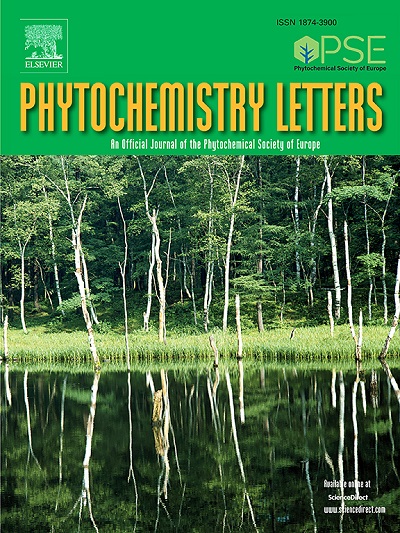非靶向植物代谢组学揭示儿茶素衍生物是 Cecropia 物种抗糖尿病活性的关键成分
IF 1.4
4区 生物学
Q4 CHEMISTRY, MEDICINAL
引用次数: 0
摘要
瓜鲁莫叶(Cecropia sp.)在拉丁美洲历来被用于控制糖尿病。这项研究旨在评估从巴拿马采集的六种 Cecropia 树种中提取的叶提取物的潜在 α-葡萄糖苷酶抑制活性。此外,还对与这种活性相关的化合物进行了表征。我们利用 UPLC-MS 非靶向代谢组学确定了最有可能具有生物活性的候选化合物。在被评估的 Cecropia 品种中,C. obtusifolia、C. hispidissima、C. longipes 和 C. peltata(CA)显示出显著的 α-葡萄糖苷酶抑制活性,与作为阳性对照的阿卡波糖(5069.72 μg/mL)相比,其 IC50 值在 9.0 到 29.8 μg/mL 之间。相比之下,C. insignis、C. heterochroma 和 C. peltata(SC)在该试验中未显示出显著影响。OPLS-DA 模型表现出很强的预测能力,能明确区分活性提取物和非活性提取物。通过这一分析,我们确定了三种假定的生物活性化合物,即原花青素 B、儿茶素和卡氏七叶皂苷 F1,它们在活性提取物中浓度较高,并表现出很强的α-葡萄糖苷酶抑制作用。此外,鉴定出的代谢物显示出 VIP 分数大于 1.5,表明它们对观察到的活性有重大贡献。这项研究确定了四种刺五加属植物是α-葡萄糖苷酶抑制剂的有前途的天然来源,它们可以帮助控制血糖水平,从而开发出治疗2型糖尿病的新疗法。本文章由计算机程序翻译,如有差异,请以英文原文为准。
Untargeted plant metabolomics reveals catechin derivatives as key contributors to the antidiabetic activity of Cecropia species
Guarumo leaves (Cecropia sp.) have been traditionally used in Latin America to manage diabetes mellitus. This work aimed to evaluate the potential α-glucosidase inhibitory activity of leaf extracts from six Cecropia species collected in Panama. Additionally, the chemical compounds associated with this activity were characterized. We identified the most likely bioactive candidates by using UPLC-MS untargeted metabolomics. Among the evaluated Cecropia species, C. obtusifolia, C. hispidissima, C. longipes, and C. peltata (CA) showed significant α-glucosidase inhibitory activity with IC50 values ranging from 9.0 to 29.8 μg/mL, as compared to acarbose (5069.72 μg/mL), used as a positive control. In contrast, C. insignis, C. heterochroma, and C. peltata (SC) did not show a significant effect in this assay. The OPLS-DA model exhibited strong predictive performance, clearly distinguishing between active and inactive extracts. Through this analysis, we identified three putative bioactive compounds, namely Procyanidin B, ourateacatechin, and kaji-ichigoside F1, that were found in higher concentrations in the active extracts and demonstrated strong α-glucosidase inhibition. Additionally, the metabolites identified showed VIP scores > 1.5, indicating their significant contribution to the observed activity. This research identifies four Cecropia species as promising natural sources of α-glucosidase inhibitors, which could lead to new treatments for type 2 diabetes by helping to manage blood sugar levels.
求助全文
通过发布文献求助,成功后即可免费获取论文全文。
去求助
来源期刊

Phytochemistry Letters
生物-生化与分子生物学
CiteScore
3.00
自引率
11.80%
发文量
190
审稿时长
34 days
期刊介绍:
Phytochemistry Letters invites rapid communications on all aspects of natural product research including:
• Structural elucidation of natural products
• Analytical evaluation of herbal medicines
• Clinical efficacy, safety and pharmacovigilance of herbal medicines
• Natural product biosynthesis
• Natural product synthesis and chemical modification
• Natural product metabolism
• Chemical ecology
• Biotechnology
• Bioassay-guided isolation
• Pharmacognosy
• Pharmacology of natural products
• Metabolomics
• Ethnobotany and traditional usage
• Genetics of natural products
Manuscripts that detail the isolation of just one new compound are not substantial enough to be sent out of review and are out of scope. Furthermore, where pharmacology has been performed on one new compound to increase the amount of novel data, the pharmacology must be substantial and/or related to the medicinal use of the producing organism.
 求助内容:
求助内容: 应助结果提醒方式:
应助结果提醒方式:


